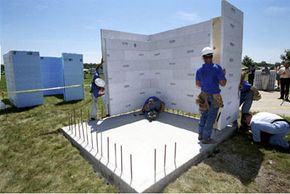Panic Room Construction and Costs
The easiest and most cost-effective way to install a panic room is during construction of a new home. You can work with an architect specializing in secure facilities or bring in a security firm during the blueprint stage. You'll probably want to tell as few people as possible about the panic room, so the designer often does not tell the contractor about it. It might be called a "mechanical room" on the blueprint, and then you'd bring in a security team after the contractors leave. You'll want to have the architectural and security firms sign confidentiality agreements to protect the secret room.
In existing homes, bathrooms, closets and wine cellars often get made over into panic rooms. A security firm can advise you on how to fortify a particular room so that it is easily accessible to you but not to intruders. Some companies also mass-produce personal safe rooms.
Advertisement
The big decisions depend on the purpose of the panic room. If you're worried about safety from intruders, most experts say the room needs to hold long enough for the police to arrive, usually 30 minutes to a couple of hours. For protection from weather-related catastrophes, placement is the most important factor. The ground floor or basement is safest against a tornado, but high ground offers better protection against floods. Supplies and stability are critical.
For safety from nuclear or biological attacks, long-term protection is necessary. The Department of Justice Emergency Preparedness manual states, "Ten square feet of floor space per person will provide sufficient air to prevent the buildup of carbon dioxide for up to five hours" [source: U.S. Department of Justice]. If you want to be able to hide out for even longer, check out fallout shelters: One German company, ABC Guard, claims it has made a portable fallout shelter that can house seven people for up to a month.
Panic Room Costs
Panic rooms are pretty expensive, but since they are mostly marketed to the very wealthy, that shouldn't come as a surprise. Construction of a high-end panic room typically starts at $50,000 and can reach beyond $500,000, depending on amenities.
On the low end, converting a closet or extra room into a panic room usually starts around $3,000. Plywood reinforcements for a closet cost about $2,500, and bullet-resistant electronic doors start at $22,000. Add another $3,000 to $10,000 if it's professionally designed.
According to one estimate on Bankrate.com, adding bullet-resistant Kevlar, a dedicated phone line, backup generator and keyless entry to an existing room can cost $40,000 to $60,000.
In the next section, we'll find out who has panic rooms and where they are most popular.
